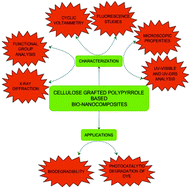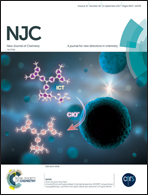Novel bio-nanocomposite materials for enhanced biodegradability and photocatalytic activity
Abstract
Novel bio-nanocomposites containing a biodegradable polymer and graphene oxide (Cellulose/Polypyrrole–graphene oxide or C/Ppy–GO) were prepared by chemical in situ polymerization and the materials were characterized by X-ray diffraction (XRD), Fourier transform infrared spectroscopy (FTIR), scanning electron microscopy (SEM), transmission electron microscopy (TEM) and energy dispersive X-ray (EDX) spectroscopy. The biodegradable polymer was prepared by chemical grafting of polypyrrole (Ppy) onto cellulose chains. The samples showed excellent biodegradability with low toxicity against food borne pathogens and can be used for biomedical applications. The samples also exhibited superior photocatalytic activity and can be used for the mineralization of dyes present in industrial effluents. Fluorescence spectra revealed that incorporation of graphene into the polymer chain supports charge separation and lowering of the charge carrier recombination, which in turn favours the photocatalytic activity of the composite. Moreover, cyclic voltammetry was used to measure the redox properties and the current producing ability of the samples. The studies suggest that electrically conducting, biodegradable and biocompatible bio-nanocomposites can be successfully prepared by chemical in situ polymerization for various applications.



 Please wait while we load your content...
Please wait while we load your content...